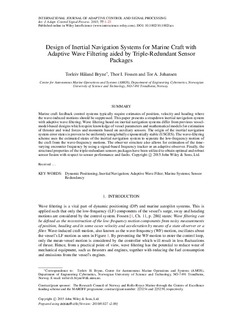| dc.contributor.author | Bryne, Torleiv Håland | |
| dc.contributor.author | Fossen, Thor I. | |
| dc.contributor.author | Johansen, Tor Arne | |
| dc.date.accessioned | 2018-01-04T16:38:53Z | |
| dc.date.available | 2018-01-04T16:38:53Z | |
| dc.date.created | 2015-05-19T11:39:18Z | |
| dc.date.issued | 2017 | |
| dc.identifier.citation | International Journal of Adaptive Control and Signal Processing. 2017, 31 (4), 522-544. | nb_NO |
| dc.identifier.issn | 0890-6327 | |
| dc.identifier.uri | http://hdl.handle.net/11250/2475806 | |
| dc.description.abstract | Marine craft feedback control systems typically require estimates of position, velocity and heading where the wave-induced motions should be suppressed. This paper presents a strapdown inertial navigation system with adaptive wave filtering. Wave filtering based on inertial navigation systems differ from previous vessel-model-based designs that require knowledge of vessel parameters and mathematical models for estimation of thruster and wind forces and moments based on auxiliary sensors. The origin of the inertial navigation system's error states is proven to be uniformly semiglobally exponentially stable. The wave-filtering scheme uses the estimated states of the inertial navigation system to separate the low-frequency motion of the craft from the wave-frequency motions. The observer structure also allows for estimation of the time-varying encounter frequency by using a signal-based frequency tracker or an adaptive observer. Finally, properties following from the triple-redundant sensor packages have been utilized to obtain optimal and robust sensor fusion with respect to sensor performance and faults. Copyright © 2015 John Wiley & Sons, Ltd. | nb_NO |
| dc.language.iso | eng | nb_NO |
| dc.publisher | Wiley | nb_NO |
| dc.title | Design of inertial navigation systems for marine craft with adaptive wave filtering aided by triple-redundant sensor packages | nb_NO |
| dc.type | Journal article | nb_NO |
| dc.type | Peer reviewed | nb_NO |
| dc.description.version | acceptedVersion | nb_NO |
| dc.source.pagenumber | 522-544 | nb_NO |
| dc.source.volume | 31 | nb_NO |
| dc.source.journal | International Journal of Adaptive Control and Signal Processing | nb_NO |
| dc.source.issue | 4 | nb_NO |
| dc.identifier.doi | 10.1002/acs.2645 | |
| dc.identifier.cristin | 1243263 | |
| dc.relation.project | Norges forskningsråd: 223254 | nb_NO |
| dc.relation.project | Norges forskningsråd: 225259 | nb_NO |
| dc.description.localcode | Copyright © 2015 John Wiley & Sons, Ltd.This is the peer reviewed version of the article, which has been published in final form at http://dx.doi.org/10.1002/acs.2645. This article may be used for non-commercial purposes in accordance with Wiley Terms and Conditions for Self-Archiving. | nb_NO |
| cristin.unitcode | 194,63,25,0 | |
| cristin.unitname | Institutt for teknisk kybernetikk | |
| cristin.ispublished | true | |
| cristin.fulltext | postprint | |
| cristin.qualitycode | 1 | |
